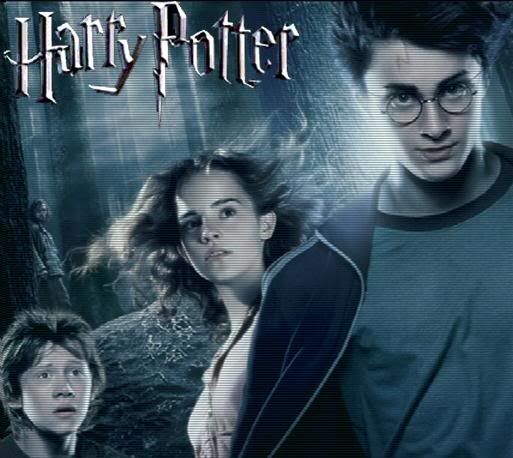
Places in Harry Potter
Wizarding Places
A. Hogsmeade
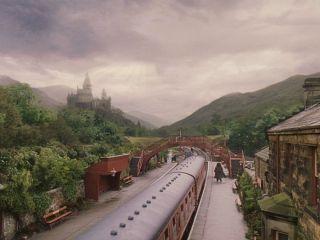 Hogsmeade, Scotland, UK is a fictional settlement that appears in the Harry Potter novels. Hogsmeade is the only pure wizarding settlement in the United Kingdom and is located south of Hogwarts School of Witchcraft and Wizardry. Third year students and older are permitted to visit the village, as long as they have a signed permission slip from their parent or guardian. Hogsmeade, Scotland, UK is a fictional settlement that appears in the Harry Potter novels. Hogsmeade is the only pure wizarding settlement in the United Kingdom and is located south of Hogwarts School of Witchcraft and Wizardry. Third year students and older are permitted to visit the village, as long as they have a signed permission slip from their parent or guardian.
 Hogsmeade remained unseen in the films, except for the short sequence where the train arrives at the Hogsmeade station in the first movie, until the release of Harry Potter and the Prisoner of Azkaban in 2004. Hogsmeade remained unseen in the films, except for the short sequence where the train arrives at the Hogsmeade station in the first movie, until the release of Harry Potter and the Prisoner of Azkaban in 2004.
B. Azkaban
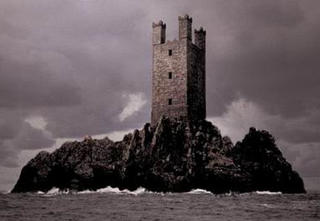 Azkaban is the fictional wizard prison in the Harry Potter series of books by J. K. Rowling. Wizards who violate the laws of the wizarding community are sent here. By the start of the series, Azkaban is guarded by the foul dementors working under the Ministry of Magic. Generally, only very severe crimes are punished with a term in Azkaban. Many of the prisoners were supporters of Lord Voldemort. According to Harry Potter and the Half Blood Prince Azkaban is located "in the middle of the North Sea," (although according to Rowling it is more specifically in the north of the North Sea.) The only island in the North Sea to meet this description (known to the Muggles, that is) would be Heligoland. Of course, Azkaban has some magic to it that hides it from the view of the Muggles. Azkaban is the fictional wizard prison in the Harry Potter series of books by J. K. Rowling. Wizards who violate the laws of the wizarding community are sent here. By the start of the series, Azkaban is guarded by the foul dementors working under the Ministry of Magic. Generally, only very severe crimes are punished with a term in Azkaban. Many of the prisoners were supporters of Lord Voldemort. According to Harry Potter and the Half Blood Prince Azkaban is located "in the middle of the North Sea," (although according to Rowling it is more specifically in the north of the North Sea.) The only island in the North Sea to meet this description (known to the Muggles, that is) would be Heligoland. Of course, Azkaban has some magic to it that hides it from the view of the Muggles.
Azkaban has a horrible and justified reputation. Its remote location is more of a precaution than a safety measure— the mass presence of dementors renders the inmates incapable of happiness and forces them to relieve their worst memories, as they become gradually helpless and very often severely insane. As dementors are extremely difficult even to injure—the only spell effective against them is the Patronus Charm, which only repels them—Azkaban was long considered escape-proof.
According to Sirius Black, because of the effects of the soul-sucking dementors many inmates of Azkaban simply stop eating and eventually die of starvation.
Prime among the crimes for which someone can be sent to Azkaban is the performing of one of the three Unforgivable Curses: the Imperius Curse, the Cruciatus Curse, and the Avada Kedavra. Performing one of these curses against any human is punishable by an automatic life sentence at Azkaban.
Azkaban has not played a direct part in the series, but lurks in the sidelines from time to time. In the second book, Hagrid is placed under temporary imprisonment at Azkaban, an experience so traumatic that he refuses to talk about it after being released. Sirius Black becomes the first wizard known to break out of Azkaban (he was actually preceded by Barty Crouch Jr., who managed to avoid detection by faking his death) in the third book. Albus Dumbledore once declared in front of the then minister of magic, Cornelius Fudge, that he could easily break out of Azkaban.
At the present moment Azkaban has been severely compromised; Professor Dumbledore has always been vocal in declaring that it was a mistake to guard Voldemort's greatest supporters with those creatures who have the most to gain if Voldemort returned to power. In the fifth book, this is in fact what happens. The Dementors leave their posts at Azkaban and join ranks with Voldemort. The prison still appears to be in use, but its emasculation has greatly harmed its effectiveness.
C. St. Mungo's Hospital
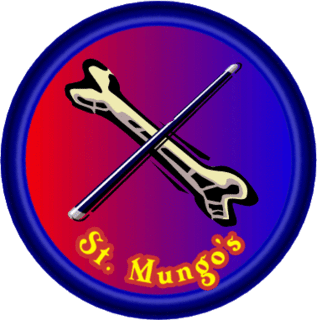 St. Mungo's Hospital for Magical Maladies and Injuries is a fictional place in the Harry Potter series of books. St. Mungo's Hospital for Magical Maladies and Injuries is the wizarding hospital of Britain. Doctors at the hospital are not called doctors, but are known as Healers. They wear lime-green robes. To become a Healer, a Hogwarts student must have N.E.W.T.s of at least grade E (Exceeds Expectations, second highest possible grade) in the subjects of Transfiguration, Potions, Charms, Herbology and Defence Against the Dark Arts. St. Mungo's Hospital for Magical Maladies and Injuries is a fictional place in the Harry Potter series of books. St. Mungo's Hospital for Magical Maladies and Injuries is the wizarding hospital of Britain. Doctors at the hospital are not called doctors, but are known as Healers. They wear lime-green robes. To become a Healer, a Hogwarts student must have N.E.W.T.s of at least grade E (Exceeds Expectations, second highest possible grade) in the subjects of Transfiguration, Potions, Charms, Herbology and Defence Against the Dark Arts.
St. Mungo's is located in London. To enter the premises, one has to step through the window of what appears to be a derelict department store called Purge and Dowes Ltd. This acts as a magical gateway to the main building, very much like the magical barrier at King's Cross railway station on Platform 9¾. The exteriors of the hospital are red-bricked and dirty, which is the complete opposite of the interiors. Inside, everything is very neat and looks exactly as a hospital should. There are six floors:
St. Mungo's was founded by Mungo Bohnam, the famous Healer, in the 1600's. The exact date is unknown. St. Mungo's emblem is a magic wand crossed with a bone.
Harry Potter first enters St. Mungo's after Mr. Arthur Weasley was attacked by a snake (Harry actually witnessed this attack in a dream). Other known characters taken to St. Mungos include:
~Professor Minerva McGonagall who had to spend some time there when she received four Stunning Spells to her chest from accomplices of Dolores Umbridge who were trying to remove Rubeus Hagrid from Hogwarts.
~Nymphadora Tonks was taken there after she was unconscious at the end of fifth book after battling with Bellatrix Lestrange.
~Katie Bell, a Gryffindor student, was sent to St. Mungo's after touching a cursed necklace she was carrying under the influence of an imperius curse.
~Gilderoy Lockhart, who inadvertantly wiped his memory.
~Frank and Alice Longbottom, tortured to insanity by Bellatrix Lestrange.
Lucius Malfoy's generous donations to St. Mungo's hospital have helped to give him influence with the Ministry of Magic and Cornelius Fudge.
Mungo Bohnam would have been named after the historical Saint Mungo (also known as Kentigern), who was the patron saint of Glasgow. "Mungo" was a nick name meaning "dear one" or "darling." He is considered the first bishop of Scotland. According to the stories about him, his pregnant mother was abandoned by her family before his birth. (source: Pocket Dictionary of Saints, published by Image Books, 1983. This theme of abandoned mothers is also found in the story of Merope, the mother of Voldemort, who was rejected by her family.
D. Ministry of Magic
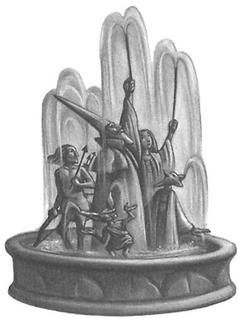 In J.K. Rowling's Harry Potter series of novels, the Ministry of Magic is the governing body of the magical community of Britain, succeeding the earlier Wizards' Council. It is known that other countries have their own Ministries of Magic. The job of the Minister for Magic seems to include executive, legislative and judicial functions. The Ministry has seven departments and many minor offices, to deal with different aspects of the wizarding world. Different departments communicate through "Inter-departmental memos", pale violet paper airplanes that will fly to their destination. In J.K. Rowling's Harry Potter series of novels, the Ministry of Magic is the governing body of the magical community of Britain, succeeding the earlier Wizards' Council. It is known that other countries have their own Ministries of Magic. The job of the Minister for Magic seems to include executive, legislative and judicial functions. The Ministry has seven departments and many minor offices, to deal with different aspects of the wizarding world. Different departments communicate through "Inter-departmental memos", pale violet paper airplanes that will fly to their destination.
The British Ministry of Magic is based in an underground location beneath London. It was revealed in the first chapter of book six that the Ministry keep in touch with the British Prime Minister with the help of a wizard's portrait in the Prime Minister's office that notifies the Prime Minister when the Minister For Magic is arriving (ususally imminently). To enter the ministry, one must dial the number 62442 into a phone booth and state one's name and reason for entering. Passes are then issued (apparently through a magical system) and the Phone booth then descends through the ground into the ministry's lobby in Floor B8.
In books one through five Cornelius Fudge served in the position of Minister of Magic, however he was sacked and Rufus Scrimgeour was given the post in book six. Below the Minister are various undersecretaries (most notably Dolores Umbridge), and heads of various magical departments. The exact structure of power within the ministry is relatively unknown.
I. Houses
A. Godric's Hollow
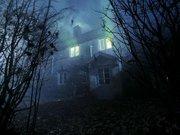 Godric's Hollow is a fictional village in the Harry Potter books by J.K. Rowling. Godric's Hollow is a fictional village in the Harry Potter books by J.K. Rowling.
It was the final hiding place of Lily and James Potter prior to being murdered by Lord Voldemort on October 31, 1981. It was at this same time that Harry Potter was left with his lightning-bolt-shaped scar.
Some readers speculate that Godric's Hollow may have been the home of James Potter's family, and/or the home of long-dead Hogwarts founder Godric Gryffindor. There is also speculation that one of Lord Voldemort's Horcruxes will be at Godric's Hollow. At the end of Harry Potter and the Half-Blood Prince, Harry Potter says he will revisit the village and his parents' graves.
As for the town's exact location, there are speculations that Godric's Hollow is somewhere in Wales (thus making Harry Potter Welsh of origin). The reason for this speculation is the fact that, when carrying baby Harry from Godric's Hollow to Little Whinging in Surrey, Rubeus Hagrid flew over Bristol - which is at the border between England and Wales.
B. The Burrow
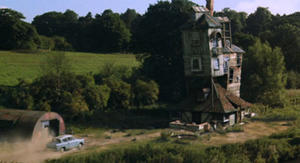 The Burrow is the fictional house which belongs to the Weasley family in the Harry Potter series of books and movies. It is located in the fictional village of Ottery St Catchpole, Devon, UK, possibly based on the real town of Ottery St Mary. The house is very tall - perhaps four or five floors high - and remains standing only by magic. There is a well-hidden Quidditch pitch nearby that is used by the Weasley boys and (secretly) by Ginny. Real Quidditch balls cannot be used in case they escape and fly over the Muggle village. The Burrow is the fictional house which belongs to the Weasley family in the Harry Potter series of books and movies. It is located in the fictional village of Ottery St Catchpole, Devon, UK, possibly based on the real town of Ottery St Mary. The house is very tall - perhaps four or five floors high - and remains standing only by magic. There is a well-hidden Quidditch pitch nearby that is used by the Weasley boys and (secretly) by Ginny. Real Quidditch balls cannot be used in case they escape and fly over the Muggle village.
The Burrow is highly magical, and most normally inanimate objects in the house have been enchanted to perform tasks automatically. A central feature of the house is a clock used by Mrs. Weasley. The hands of the clock represent members of the family, and the markings on the clockface are conditions and locations. With this, she can tell if any member of her family is at home, asleep, travelling, or in danger. The house also has a ghoul in the attic who keeps Ron Weasley awake at night by banging on the plumbing. The house provides a safe and fun place for Harry Potter to stay during the summer holidays, when he cannot stay at Hogwarts School of Witchcraft and Wizardry.
The Burrow is home to Arthur Weasley, Molly Weasley, Bill Weasley, Charlie Weasley, Percy Weasley, Fred Weasley, George Weasley, Ron Weasley, and Ginny Weasley.
Cedric Diggory's family lives near the Burrow and Luna Lovegood's may as well.
II. Schools
A. Hogwarts
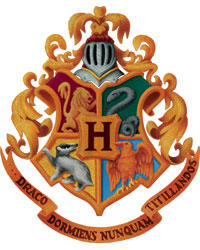

B. Beauxbatons
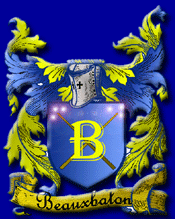 Beauxbatons Academy of Magic is a fictional magic school similar to Hogwarts in the Harry Potter series of books. It was first introduced in Harry Potter and the Goblet of Fire and existed at least 700 years ago, as that was when they began participating in the Triwizard Tournament. Beauxbatons is located in France and its headmistress is Olympe Maxime. Beauxbatons Academy of Magic is a fictional magic school similar to Hogwarts in the Harry Potter series of books. It was first introduced in Harry Potter and the Goblet of Fire and existed at least 700 years ago, as that was when they began participating in the Triwizard Tournament. Beauxbatons is located in France and its headmistress is Olympe Maxime.
Some have speculated that since bouillabaisse was served at the opening feast of the Triwizard Tournament, and this fish soup is generally served in southeast France, one could assume that Beauxbatons is somewhere on the Mediterranean coast of France, perhaps Marseille. This would also explain why Beauxbatons students are so cold when they are in Hogwarts.
The students' uniforms also suggest they are accustomed to warmer weather than what they encounter at Hogwarts. Beauxbatons uniforms are made of light blue silk, and the school coat of arms is two golden wands crossed over one another, each shooting three stars. Beauxbatons students stand at attention from when their headmistress enters the room until she seats herself. They also seem to care more about their studies and their school's reputation.
The Academy is in a glittering palace, probably newer and brighter than Hogwarts Castle. The food, at least according to Fleur Delacour, is delicious but much lighter than the food served at Hogwarts. Students are serenaded while they dine by choirs of wood nymphs. At Christmas time the dining hall is adorned with great, non-melting ice sculptures. Beauxbatons is Unplottable, so no muggles or even wizards from rival schools can find it on a map, and it may be disguised so no one can really see it unless they know to look for it. The Academy has existed for over seven hundred years, and was part of the Triwizard Tournament since its founding.
"Beaux bâtons" is French for "beautiful sticks." The "bâtons" part is presumably a reference to magical wands. The French word for "magic wand" is "baguette magique", which would make most people in the English-speaking world think of a loaf of bread, so it's not surprising Rowling didn't use it.
As both Hogwarts and Durmstrang are in castles and Fleur Delacour said Beauxbatons was a palace, it is likely that Beauxbatons is also inside a castle. Beauxbatons competed in the 1994 Triwizard Tournament. The champion for Beauxbatons turned out to be Fleur Delacour. Fleur wasn't impressed with Hogwarts, and spent much of her time bragging about how much better Beauxbatons was.
In Harry Potter and the Order of the Phoenix, Olympe Maxime journeyed with Hagrid to get the giants on Dumbledore's side before Lord Voldemort could. It isn't known who took over the headmastership.
C. Durmstrang
 Durmstrang Institute for Magical Study is a fictional magic school in the Harry Potter books, similar to Hogwarts. Durmstrang is thought to be located in eastern or northern Europe, probably in Scandinavia, or less likely, northwestern Russia, although that name points to its German origin. Given the historically strong German and Austrian cultural and political influence on all Middle and Eastern Europe, German can as well be the language of instruction. The school existed at least 700 years ago, as that was when they began participating in the Triwizard Tournament. Durmstrang Institute for Magical Study is a fictional magic school in the Harry Potter books, similar to Hogwarts. Durmstrang is thought to be located in eastern or northern Europe, probably in Scandinavia, or less likely, northwestern Russia, although that name points to its German origin. Given the historically strong German and Austrian cultural and political influence on all Middle and Eastern Europe, German can as well be the language of instruction. The school existed at least 700 years ago, as that was when they began participating in the Triwizard Tournament.
Like Hogwarts, Durmstrang is located inside a castle. The castle is only four stories tall and fires are only lit for magical purposes. It has very extensive grounds, suggesting it is far from the sea. Durmstrang has a reputation for teaching the Dark Arts, possibly because of its former headmaster, Igor Karkaroff. Karkaroff was a Death Eater, but he got out of Azkaban by giving the Ministry of Magic dozens of names of his co-conspirators. He does not admit Muggle-borns to his school, and is said to have not only been teaching them Defence against the Dark Arts but the Dark Arts themselves.
Bulgarian Quidditch Seeker, Viktor Krum, attended Durmstrang, and was still in school during the 1994 World Cup. In the 1994 Triwizard Tournament, Durmstrang's champion was, to nobody's surprise, Viktor Krum. It was ironic that Krum attended the Yule Ball with Hermione, who is Muggle-born and would not have been admitted at his school.
After the events of Harry Potter and the Goblet of Fire, Karkaroff fled after Lord Voldemort rose again. In the sixth book it is mentioned that Karkaroff was killed by the Death Eaters. It is not known who took over, or whether the school's reputation improved or worsened due to this.
III. Alleys
A. Diagon Alley
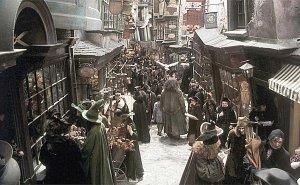 In J. K. Rowling's Harry Potter novels and their filmed adaptations, Diagon Alley is a large alleyway in London accessible to witches and wizards but hidden from Muggles. It appears to be the economic hub of Britain's sparse Wizarding world. It is home to Ollivander's, makers of magic wands since 382 BC and likely the country's primary supplier, as well as the goblin-run Gringotts Bank. Other establishments include the Flourish & Blott's bookstore, Eeylops' Owl Emporium, Quality Quidditch Supplies and The Leaky Cauldron Inn. For those shopping for Hogwarts equipment, Diagon Alley serves all needs. Gringotts operates a money-changing service for the Muggle-born. In J. K. Rowling's Harry Potter novels and their filmed adaptations, Diagon Alley is a large alleyway in London accessible to witches and wizards but hidden from Muggles. It appears to be the economic hub of Britain's sparse Wizarding world. It is home to Ollivander's, makers of magic wands since 382 BC and likely the country's primary supplier, as well as the goblin-run Gringotts Bank. Other establishments include the Flourish & Blott's bookstore, Eeylops' Owl Emporium, Quality Quidditch Supplies and The Leaky Cauldron Inn. For those shopping for Hogwarts equipment, Diagon Alley serves all needs. Gringotts operates a money-changing service for the Muggle-born.
Entrance by foot is shown to be done by going through the Leaky Cauldron pub (invisible to Muggles) and tapping the bricks of a wall behind it with a wand and in a certain order. Given the busyness of the area, travelling to and from the Alley is likely typically done by more magical means. In the first film, Diagon Alley appears to be a short walk away from Leadenhall Market in the City of London.
The name seems a possible pun on "diagonally"; evidence for that can be found in the movie version of Harry Potter and the Chamber of Secrets. The DVD of that movie includes a video "guided tour" of Diagon Alley, apparently shot on the original movie sets.
Leading off of Diagon Alley is the dark and dingy Knockturn Alley (probably a pun on "nocturnally") – much the same, only Dark.
B. Knockturn Alley
Knockturn Alley, a pun on nocturnally, is a fictional location in J. K. Rowling's Harry Potter series of novels. Leading off of the more savoury Diagon Alley, Knockturn Alley is a dark and seedy alleyway in London to which muggles have no access, and where no respectable witch or wizard ought to be found either. All of the shops and stores in Knockturn Alley are devoted to the Dark Arts; the largest and most disreputable is Borgin & Burkes, which sells sinister and dangerous objects.
Despite its reputation, Hagrid visits Knockturn Alley in Harry Potter and The Chamber Of Secrets in search of Flesh-Eating Slug Repellent and other items which he presumably requires for the care and feeding of the exotic and dangerous creatures to which he tends to become attached.
Harry, while travelling via floo powder to Diagon Alley, accidentally landed in Knockturn Alley, where he spied on a conversation between Lucius Malfoy, his son and Mr. Borgin. Harry was discovered by a witch who clearly wanted to take advantage of him being lost and vulnerable, but he was rescued by Hagrid.
Muggle-Related Places
A. Kings Cross Station
 King's Cross station is a railway station in Kings Cross to the north east of central London. It is located in the borough of Camden, and is the southern terminus of the East Coast Main Line. It is immediately adjacent to St Pancras station. King's Cross station is a railway station in Kings Cross to the north east of central London. It is located in the borough of Camden, and is the southern terminus of the East Coast Main Line. It is immediately adjacent to St Pancras station.
The station serves routes to the North East of the UK, including Cambridge, York, Durham, Newcastle and Edinburgh. King's Cross also incorporates a major Underground station known as King's Cross St. Pancras, which is a major interchange station on the Tube network.
King's Cross features in the Harry Potter books, by J. K. Rowling, as the starting point of the Hogwarts Express. The train uses a secret platform 9¾ located by passing through the barrier between platforms 9 and 10.
Unfortunately, platforms 9 and 10 are in a separate building from the main station and face each other across the intervening tracks: Rowling intended the location to be in the main part of the station, but misremembered the platform numbering (in a 2001 interview she indicated she had actually confused King's Cross with Euston; hence also the wall/barrier confusion).
When the books were filmed, the main station was used, with platforms 4 and 5 renumbered 9 and 10 for movie purposes. In the Harry Potter and the Chamber of Secrets film the exterior of the nearby St Pancras railway station was used, as St Pancras with its Gothic façade was considered more impressive than the real King's Cross. A cast-iron "Platform 9¾" sign has been erected on a wall of the station's suburban building where the real platforms 9 and 10 are. Also shown in the photograph is the recently added luggage trolley; the end sticks out visibly, but the body of it has mysteriously disappeared into the wall....
B. Little Whinging
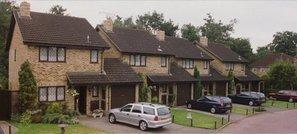 Little Whinging, Surrey, England, is a fictitious town to the south of London, described in the Harry Potter series of novels. It was Harry's home for roughly the first 10 years of his life, where he lived with his cruel aunt, uncle and cousin, the Dursleys at Number Four Privet Drive. The author, J. K. Rowling, designed this place to be the most bland and stereotypical town in London's commuter belt in order to contrast it with the unique and spectacular Hogwarts School of Witchcraft and Wizardry. Harry despises Little Whinging because of his memories of his treatment there, but in Harry Potter and the Order of the Phoenix, Dumbledore reveals that there is a reason why Harry must return there at least once a year. Little Whinging, Surrey, England, is a fictitious town to the south of London, described in the Harry Potter series of novels. It was Harry's home for roughly the first 10 years of his life, where he lived with his cruel aunt, uncle and cousin, the Dursleys at Number Four Privet Drive. The author, J. K. Rowling, designed this place to be the most bland and stereotypical town in London's commuter belt in order to contrast it with the unique and spectacular Hogwarts School of Witchcraft and Wizardry. Harry despises Little Whinging because of his memories of his treatment there, but in Harry Potter and the Order of the Phoenix, Dumbledore reveals that there is a reason why Harry must return there at least once a year.
The name "Little Whinging" is probably a pun on "whingeing", which is English slang for endlessly complaining about something. (The equivalent word in American English is whining.)
The owner of the house used in filming subsequently had difficulty selling it, despite hoping its status would command a massive premium.
|
Wizard Profile:
About me!
Recent Spells:
Quidditch
About Harry Potter
Wizard Web:
Harry James Potter
|